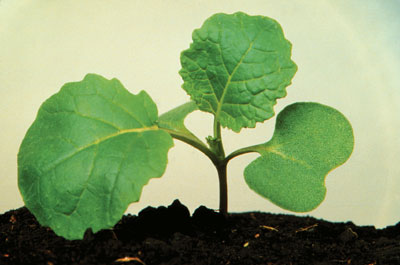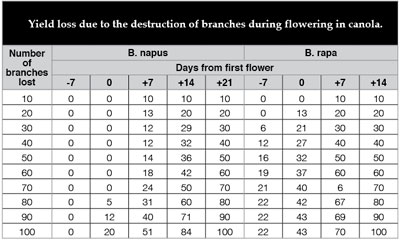
Features
Agronomy
Insect Pests
Managing canola after the big white combine
Every year, hail rolls through parts of the Prairies, and with a little luck, canola fields escape unscathed. But what happens when hail hits your fields? That depends on the stage of the crop. The least impact that hail can have on a canola crop is at the seedling to early vegetative stage. “One thing we’ve learned over the years,” says Canola Council of Canada agronomy specialist Doug Moisey at St. Paul, Alberta, “is that young canola is amazingly tough. Don’t panic. Let nature do her work. Growth will be delayed, and growers will have to pick up on their management for the rest of the season."
March 18, 2010 By Bruce Barker
Every year, hail rolls through parts of the Prairies, and with a little
luck, canola fields escape unscathed. But what happens when hail hits
your fields? That depends on the stage of the crop. The least impact
that hail can have on a canola crop is at the seedling to early
vegetative stage. “One thing we’ve learned over the years,” says Canola
Council of Canada agronomy specialist Doug Moisey at St. Paul, Alberta,
“is that young canola is amazingly tough. Don’t panic. Let nature do
her work. Growth will be delayed, and growers will have to pick up on
their management for the rest of the season.”

|
| Seedling canola can recover from hail damage. (Photo courtesy of the Canola Council of Canada)
|
After a hail storm, Moisey says to be patient and let the crop recover
for three to five days before making any decision on reseeding. He says
that growers first need to walk their hail-affected fields within a few
days to check for the green growing point on the plants. Scout many
areas of the field taking square foot or square meter readings where
damage seems both light and extensive.
Moisey explains that canola plants injured in the seedling stage may
have either one or both cotyledon leaves missing, the seedling beaten
down, or the stem broken at the soil line. The main thing to inspect
for is the growing point in the centre of the damaged plants. Plants
with both cotyledons broken or torn off, and those broken off below the
cotyledons with no visible growing point, usually do not survive. By
giving the crop time to recover, it will help determine the survivors
from the victims.
Canola Council information on hail damage indicates that an average
stand of 12 to 14 plants per square foot can be reduced to fewer than
four plants per square foot before yield losses exceed 10 percent.
While the ideal canola plant populations is above five plants per
square foot, herbicide tolerant varieties with good fertility and
moisture can produce a successful crop with just two to three plants
per square foot.
The canola crop may be able to recovers its yield potential if the
remaining plant population is still high enough, above that five per
square foot, because the remaining seedlings take advantage of the
reduced competition for light, moisture and nutrients.
Moisey says properly timed weed, disease and insect control will be
critical to allow the crop to compensate for damage. It is likely that
it will take the stands longer to mature, and maturity may be more
variable throughout the field, so swathing timing will also be very
important. “I, personally, have never made a recommendation to reseed a
canola crop after it was hailed in the seedling stage. Typically, the
crop can recover really well, but the plants need time” says Moisey.

|
Greater damage at later stages
The majority of the yield loss caused by hail damage in the early
vegetative stages comes from injury to the leaf canopy. If hail bruises
the main vein on a leaf, or the main vein is torn, broken and wilted,
the leaf will likely die. Since leaf area is very important for
photosynthesis, lost leaf area equals reduced seed yield. Lost seed
yield equals about 25 percent of the lost leaf area.
For example, if 50 percent of the leaf area was removed by hail, the
estimated yield loss would be: 50 percent leaf area damaged or lost
multiplied by 25 percent equals 12.5 percent potential yield loss.
At the flowering stage, damage is more noticeable, with young flower
clusters torn off. But even then, the canola may be able to make a
partial recovery. The Canola Council’s Grower Manual states, “A well
established root system and the ability to develop secondary flower
clusters help the plant recover. When buds and flowers are lost due to
injury, the plant recovers rapidly by the development of flowers that
normally would have been aborted. The plant also develops flowering
branches from growth buds lower down on the plant, replacing, to a
degree, the lost buds, flowers and pods.”
Research stretching back to the 1980s conducted at the Agriculture and
Agri-Food Canada Saskatoon Research Centre provided estimates of yield
loss due to hail damage.
B. napus varieties have also shown a greater ability to recover from loss of flowering branches than B. rapa varieties.
Plant pathologist Philip Northover with Manitoba Agriculture, Food and
Rural Initiatives at Carman, says that disease is another cause for
concern when hail damages a canola crop. “There is a risk of added
disease pressure, absolutely,” he says. “It depends on the level of
sclerotinia or blackleg already present in the field, but the wounds
can create entry points for the pathogens to exploit.”
Worst damage at podding
Possibly the most damaging, and disheartening, time for hail is just
prior to harvest, once the pods are starting to fill. At this stage,
the plant cannot compensate for the lost yield. Bruising on pods
usually means incomplete filling of the seed inside the pod. The result
is shriveled seeds and lost yield. “Another challenge at this stage is
deciding when to swath. Hail-damaged pods may turn white and mature
faster than the undamaged pods. You have to make a decision on what
timing is best to save the most yield,” explains Moisey. “You’re going
to have to check the fields every few days to hit the best timing.”